A Proud History
The New Zealand Spinning, Weaving and Woolcrafts Society Incorporated
How It All Began
In 1966 Colin Southey, a Department of Agriculture Sheep and Wool Instructor in Wairoa, gave a talk on wool to the recently formed spinning group in Wairoa. Resulting from this developed the idea to promote Wairoa and wool crafts. Through Colin’s efforts the first Wool Week was staged in Wairoa in 1967.
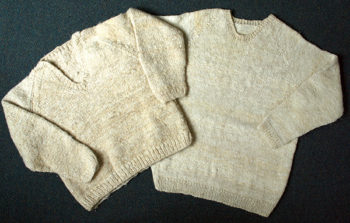
After much discussion on how to get nationwide media attention the Wool Week committee organised a world record attempt for fleece-to-garment of a man’s jersey. There were two teams, one led by Sally Smith to use the traditional Maori method of pulled wool which became known as kiwicraft, and the second led by Thelma Powell to spin the wool before knitting. Only four knitters at a time were permitted. Judging was based on quality of pulling, spinning, knitting, conformation to pattern and time. This event was televised and created interest around New Zealand and the world. National interest was then roused by the record breaking event and it was at this time that kiwicraft was first brought to the notice of the public.
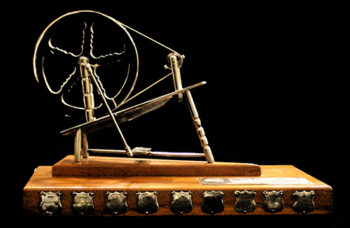
Hawkes Bay Farmers Cooperative Co. sponsored the idea the following year and produced an outstanding trophy, a silver spinning wheel, designed by their district display artist Alan McCormick of Hastings, and crafted by Martin Metz of Wairoa. The man’s jersey set-up was too cumbersome so Mr Southey and Thelma Powell developed a child’s jersey concept with six in a team and a scoring system based on speed, quality and accuracy to the pattern.
Ten teams of six took up the challenge at the 1968 Wool Promotion Week which was won by the Woolly West Coasters. The Silver Spinning Wheel Trophy and a cheque for $120 was presented by the Wairoa Director of Hawkes Bay Farmers, Mr Eric Powdrell.
A trophy in the form of a carved mere, the work of Barlow Mei, was donated by his parents for the kiwicraft event.
1969
Wairoa handed the competitions to Gisborne for the 1969 Cook Bicentenary celebrations. By this time action competitions were popular and with this level of interest it was realised that there needed to be some standardisation of competition rules.
The Wairoa Wool Committee realised that a national organisation was required. Colin Southey outlined a format that he could see would work with the wide variation of interested personnel – two Vice-Chairmans, (North & South Island), elected delegates from each area, and a Chairman who had no affiliation to any group. It was thought Mr Eric Powdrell would be well suited to the position of Chairman. This concept was agreed to.
The wool Committee decided to ask Mr R E Shortt MBE, Mayor of Wairoa, to sign the letter to invite interested personnel to Wairoa with the object to form a national body.
The invitation to attend the meeting went out on April 30, 1969 to all those who had attended or competed in the Silver Spinning Wheel competition at the Gisborne bicentenary celebrations. More than 70 men and women attended the meeting on 5 July 5 1969 and after many hours of discussions it was agreed that a national body should be formed. The New Zealand Spinning, Weaving and Woolcrafts Council was born and the following officers were elected:
Patron: Mr R E Shortt MBE
President: Mr E S Powdrell
Vice-Presidents: Mr Colin Southey (North Island) and Mrs Mary Moore (South Island)
Secretary-Treasurer was left for the incoming executive to appoint. From 15 nominations the following nine were elected to the committee:
Lady Dorothea Turner, Mrs Beth Mathieson, Mr B. Hunter, Mrs J. Stovell, Mrs Sally Smith, Mrs M. Bartlett, Mrs B. D’Arcy-Smith, Mr J.S. Standring and Mrs S. Hickling.
In general business rules were set for the action competitions and it was decided that groups, clubs or organisations wishing to join the New Zealand Spinning and Woolcrafts Council apply to the executive and pay $10 affiliation fee per annum. At the Council meeting held on Tuesday 19 August, Mrs C Goldsmith was appointed Secretary-Treasurer. It was decided that the Council become an incorporated body.
At the next Council meeting in September in Wairoa samples of motifs for the Council’s letterhead were submitted and the design chosen depicted a blue spinning wheel super-imposed upon a yellow map of New Zealand. The council also decided to subsidise the travelling and accommodation expenses of members attending council meetings.
It was decided to send a letter to weaving guilds setting out details of the council and inviting them to be represented on the present executive committee. Mrs Mary Moore with Lady Turner compiled a letter which was sent to the Handweavers Guild, Auckland, Manawatu Spinners and Weavers, Waikato Spinners and Weavers, and Wellington Hand Spinners and Weavers.
Submissions from the Handweavers Guild, Auckland, and Dorothea Turner were presented to the first 1970 meeting held at Wairoa in February. The Handweavers Guild submission brought up points which led to determining the overall aims of the Council:
To bring together men and women who practise the art of handweaving,
spinning and other allied crafts for their mutual benefit, for the advancement of the craft by discussion,
demonstration and exhibition and for such other purposes as the Council might hereafter determine.
The guild informed the meeting it would hand over control of its magazine, The Three Crafts Journal, to the national council. The following sub-committees were set up to deal with the various aspects of the Council’s business:
Newsletter: Mrs Jean Timlin
Information and Education: Mrs Ans Loman
Judging: Mrs Jenny Poore
Competitions and Calendar Mr Colin Southey
1970
The first annual general meeting and subsequent executive meetings were held during Wool Week at Wairoa from 15–17 April 1970. There were full discussions on the aims of the Council, membership of the national body, the Council’s magazine and quarterly newsletters, suggestions for the alterations of the rules for the Silver Spinning Wheel competition and a name for the national body. The organisation grew rapidly. During the executive meeting in July 1970, it was decided that the country be divided into fourteen areas, each electing a delegate to attend national meetings as part of a national executive. This was complete by 1971. Only persons who had paid 50c membership fee to the Council were entitled to vote for a delegate in their area. Each delegate maintained contact with the area’s constituent groups which organised themselves according to their particular needs.
Mrs K. Low represented the council at the 1970 Arts Council conference. The Hutt Arts Society Weavers organised a national floor rug competition in conjunction with a handweaving exhibition which was held in Kirkcaldie and Stains, Wellington. The movement’s first overseas exposure was at Expo ‘70 in Tokyo but nearly did not happen. Whilst crafts people throughout New Zealand had been asked to submit work, spinners and weavers had been ignored. Strong action was called for. Dorothea Turner with Mary Moore and her husband John, a Marlborough sheep farmer, went to see the Minister of Overseas Affairs, Lance Adams-Schneider, at Parliament Buildings. They were too late as New Zealand’s exhibits had already left the country by ship. However, 100 sq ft of wall space was made available and if woolcraft articles were ready by a certain time they could be flown to Japan. There was some hasty work done up and down the country!
The stock and station firm, Merck Sharp & Dohme Ltd, together with the council, planned a project whereby six handweavers were invited to spin and weave one each of the 1970 Golden Fleeces into a garment length appropriate to the type of wool. These six fleeces were the country’s best for the year in their respective breeds. The fabrics were displayed with the 1971 Golden Fleeces at the Land and Industries Exhibition in Dunedin and toured New Zealand.
During 1970 two papers were presented to the council. Kathleen Low’s paper on exhibitions and competitions covered the planning, conditions of entry, handling of exhibits, display, cataloguing and sales. Jenny Poore’s paper on judging covered the method and the points to look for in a prize winning entry.
1971
In 1971 Mr R E Shortt, MBE, resigned as Patron and was appointed Honorary Vice-President. Lady Porritt, wife of the Governor-General, became Patron. Many areas had been formed and delegates appointed, or were in the process of being appointed.
The 1970s was a time of tremendous growth in the arts and crafts generally and woolcraft followed the trend enthusiastically. Groups met regularly and many area spin-ins or woolcraft days were arranged. Local agricultural and pastoral shows brought woolcraft to a wider audience, while families wearing handspun and handknitted garments showed the versatility of the end product.
Workshops and courses were organised and groups set up their own libraries. National standing committees for various purposes were also set up.
In 1970 the council’s annual competition and display was still tied in to the Wairoa Wool Promotion Week but by 1971 Wairoa could not accommodate the 1000 strong membership. Bay of Plenty picked up the challenge and at Whakatane staged what became the first national festival.
It was in this year that annual membership cards were first issued to financial members, these cards later to be colour designated for that year’s festival.
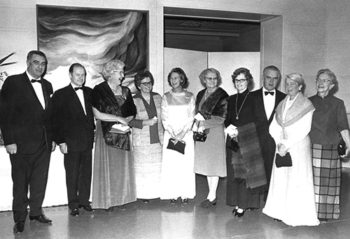
To raise the standard of workmanship of handspun and handwoven articles offered for sale, 1971 saw the establishment of a quality mark system and with New Zealand Wool Board participation, the design and registration of a Quality Mark logo. A sub-committee was formed to administer the scheme and evaluate the work submitted.
David Kent’s design was chosen for Quality Mark labels and was also adopted as the council’s official logo and new letterhead.
A weaving competition was sponsored by the Reserve Bank of New Zealand and a selected exhibition of entries was mounted in the New Zealand Academy of Fine Arts gallery. Margery Blackman, Dunedin, won the floor rug section; Elizabeth Allan, Christchurch, the table mats and Judy Patience, Wellington the wall hanging.
Membership in 1971 was 1,629 at a capitation fee of 50c each.
1972
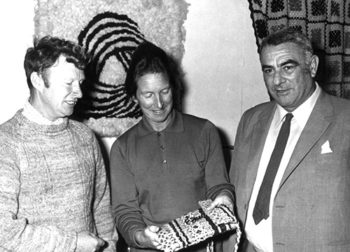
After much discussion the Council changed its name to the New Zealand Spinning, Weaving and Woolcrafts Society and the process of incorporation was completed. Southland hosted the first National Woolcrafts Festival in Invercargill.
Membership had risen to 2,363 plus 26 individual members.
1973
This year was the first in which the Wool Board trophy was presented. Awarded for the best article in wool in a festival exhibition, it was won that year by Mrs J. Fraser.
The first assessment for Quality Mark was held in Christchurch for spinning and weaving, submitted articles to be suitable for sale to the public.
Esther Tyler, first Editor of the web for the Society, resigned and was replaced by Margaret Boyce of Hamilton.
The name of the Exhibition Committee was changed to Projects Committee. With Judith Plowman as Convenor, the standing committee for Education Information and Research was set up, retaining the services of Margery Blackman and Dot Staub as consultants.
Relda MacDougall, Canterbury Area Delegate, reported on plans for a woolcraft shop to be opened during the Commonwealth Games to be held in Christchurch the following year. Members throughout the country were asked to send articles for selection either for sale or exhibition, and for entries in a jersey competition. The Yarn Spinners shop proved a huge success, making $2,000 profit which helped put the Society on a firm financial basis. Fifty-three jerseys were entered in the competition which was won by Gillian Kain of Gisborne. They were added to the other stock – knitted, crocheted and woven articles of every kind – 2,262 in all. No record exists of the number visiting the shop but it was estimated at some thousands. Stocks to the value of over $11,000 was sold over the ten days the shop was open.
In May the Arts Council requested a list of weavers and weaving groups capable of producing a wool wall hanging for the main foyer of the new Beehive Parliamentary Building in Wellington. Sixteen weavers and weaving groups submitted designs. Joan Calvert of Wellington was the weaver commissioned to make the 4.6 metre by 7.3 metre hanging for the Beehive. It was designed by Guy Ngan, Stokes Valley. Dorothea Turner and Jean Ngan helped Joan with the weaving
The Society received a $500 donation from the profits of the Dannevirke festival.
Membership now numbered 2,600.
1974
- Betty Watson resigned as Secretary-Treasurer and Sylvia Cole was appointed. Lady Ballantrae accepted the position of Patron.
- Dorothea Turner retired as Convenor of the Projects Committee. She was followed by Annette Littlejohn.
- A gold brooch in the form of the New Zealand Wool Board trophy, supplied by the Board, was presented for the first time to the trophy winner.
- The national festival at Greymouth was very successful and $1,271 was donated to the Society by the organising committee.
- Society membership was 3,019.
1975
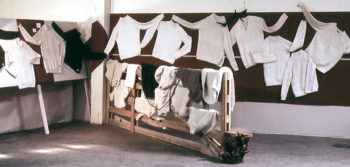
- Festival held in Whangarei. Classes and discussions were held for the first time and proved very successful. There was a general demand for more knowledge, for weaving tutors at all levels and for tutors of spinning at more advanced stages. A grant was made by the Ministry of Recreation and Sport to help finance this.
- This year was a time of change for the Society with the resignation of the inaugural President, Eric Powdrell. He was replaced by Dorothea Turner. Judith Field became the new Secretary-Treasurer and the Web editorship was taken over by Nancy Strang, Balclutha.
- Early in the year an Executive Council of the President, two Vice-Presidents, Secretary-Treasurer and Convenor of the Project Committee was formed to deal with the Society’s business between the six-monthly full executive meetings. A standing committee for action competitions was set up with Judith Field as convenor, to run and control Silver Spinning Wheel and Kiwicraft competitions.
- In May the first residential school was held at Lincoln University, Christchurch. It catered for 150 people with a range of lectures, classes, visits and the opportunity to exchange ideas.
- Society weaving came into its own in 1975 with the first exhibition of Handweaving Unlimited arranged by the New Zealand chapter of the Worlds Crafts Council and held at the Academy of Fine Arts Gallery, Wellington.
- Cross Country Weavers was formed, led by Pauline Pease, and the judging committee disbanded, its functions having been absorbed by other standing committees.
1976
- Festival held in Hamilton. A highlight of the year was a craft exhibition arranged by the New Zealand Academy of Fine Arts to mark the conference of Commonwealth Universities Vice-Chancellors, selected by the Projects Committee.
- The Handweaving Unlimited exhibition was again staged by the New Zealand Academy of Fine Arts in association with the Society. Dowse Gallery, Lower Hutt mounted a national weaving award exhibition with Georgia Suiter winning the traditional section and Margaret Thomson the section for off-loom weaving.
- Eric Powdrell was named as the Society’s founder, his name to be recorded between that of the Patron and the President, and at the same general meeting he was elected a life member.
- A division of festival profits was agreed at 60 percent to the Society and 40 percent to the organising area.
- The Wool Board showed concern for the Society’s problems and made available rooms for Executive and Quality Mark meetings. It acted as depot for Quality Mark submissions. A non-competitive selected section was included in the festival exhibition for the first time.
- Membership had climbed to 4,451.
1977
- Festival hosted by Nelson/Marlborough area in Nelson.
- A Wool Board sponsored fashion parade was mounted at the 1977 Ruakura Field days. Fabrics woven by Society members were selected by the Board’s fashion advisers and Mr Peter Rigby, couturier to the Board. Barbara Wilson organised the event which called for six models doing seven parades between 10am and 3pm. The garments took a real pounding.
- Jenny Poore became the new President. Dawn Davenport was appointed Convenor of the newly established fashion committee and Dorothea Turner was appointed the Society’s first publications editor on her retirement from the Presidency.
- The Wool Board sponsored a woolgrowers award for handcrafted wool fashion at the Benson and Hedges parade, New Zealand’s premier fashion event. The award was won by Pauline Warrington and Mary Reynolds.
- On an Arts Council grant, Kathleen Low visited the Chatham Islands to teach spinning, weaving, plant dyeing and crochet, encountering great interest. Later in the year she was appointed fibres adviser to the National Art Gallery.
- Several members were awarded life membership during 1977 for special achievements: Kathleen Blowes; Olive Hay; Lise Jaeger; Marion McLeod; Perrine Moncreiff JP CBE; Elsie Ryan and Aileen Stace.
- Judith Field, at the heart of the Society since its inception, was also awarded life membership (year unknown). She was Hawkes Bay Delegate from 1971, Acting Secretary and North Island Vice-President in 1974 and became Secretary-Treasurer in 1975. When she retired from office of Treasurer in 1980, the Society was approaching its peak of over 7,000 members, in some measure due to her enthusiasm.
- Membership had now reached 5,305.
1978
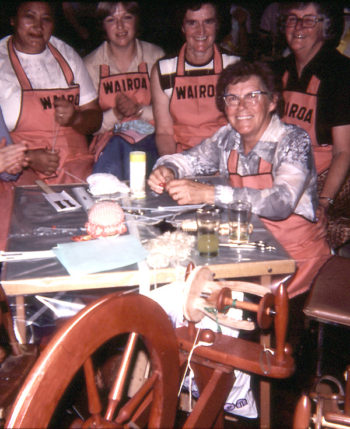
Festival held at North Shore, Auckland. Wellington Delegate Ann Hayman visited the Chatham Islands on a QE II grant following up the work of Kathleen Low the previous year. A sterling silver brooch in the form of the Society’s logo became available to members.

Membership grew to 6,241 and pressure of work on the Secretary demanded separation of the Secretary’s and Treasurer’s functions. Ellen Whitlock was appointed Secretary and Judith Field carried on as Treasurer.
1979
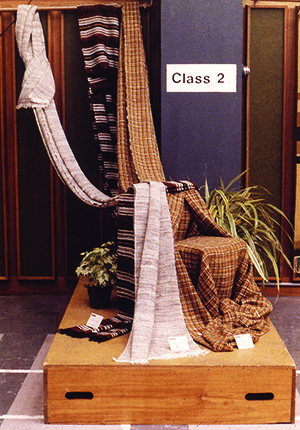
Festival hosted by Canterbury and held in Christchurch. During that year the first film about woolcrafts in New Zealand, Woollen Piece was presented by the National Film Unit to the Society. It included scenes from the national festival in 1977.
The Society joined ANZAS (Associated New Zealand Arts Societies) following a craft summit meeting in May. The President, Jenny Poore, and Kathleen Low, represented the Society at this meeting which discussed interests common to crafts people, such as sales tax. After 18 months of consultation with the Customs Department about sales tax on art weaving, the following definition was made: ‘The production of original art works being handweaving on a loom or without a loom’. This meant that artist weavers did not have to be licenced under the sales tax act and did not have to pay tax on weavings sold.
Kathleen Low, a foundation member of the Society and involved in its administration from the beginning, became a Life Member. She was a member of Aileen Stace’s spinning group in Eastbourne and became the leader of a small weaving group formed in 1966. A connection with the Reserve Bank of New Zealand led to the Reserve Bank weaving awards.
Membership was still growing and now stood at 7,357.
1980
Festival held in Palmerston North. Anne Hayman became President. Dorothea Turner was awarded Life Membership. In 1968 she was at Wairoa as a judge for the first Silver Spinning Wheel competition, an executive member when the Society was formed in 1969 and President from 1975–1977. She also served as Convenor of Projects and later Publications. In 1962 she joined a few spinners who, like herself were looking for weaving tuition. The group grew and became the Wellington Guild, then its eastern members branched off to become the Hutt Art Society Weavers, to which she transferred. Later she was one of the 50 who formed the Port Nicholson Handweavers.
Jenny Poore was also awarded Life Membership in 1980. She was President of the Society from 1977–1980 and a past president of the Handweavers Guild, Auckland. She became very proficient in the three crafts of spinning, weaving and dyeing and has a natural talent for teaching. Her willingness to share her knowledge has made her a well-known and loved member of the Society. Her interest in fibre led to her writing a Society publication on mohair.
The Society’s guide containing all information about the Society was reprinted.
1981
Otago area hosted the festival which was held in Dunedin.
The very large Canterbury area was divided to become Canterbury and South Canterbury. Also that year it became policy to supply all new groups joining the Society with a pack containing a mailing list, copy of the constitution, Society Guide, latest news bulletin, notes on affiliation procedure and a list of Society publications.
The standing committee for fashion was disbanded, with future festival parades to be under the control of the Area Delegate with the assistance of the Quality Mark committee if needed.
1982
Wellington festival held in Lower Hutt.
President Anne Hayman visited workshops in Australia, Scandinavia, United Kingdom and America on a Churchhill Memorial Fellowship to study the formation and administration of workshop galleries with the possibility of a permanent workshop in New Zealand in mind. It was decided that the project was not feasible on the grounds of cost.
In the New Year’s Honours list Nancy Strang received a QSM for public service which included her service as Web editor.
The first of a series of successful spinning schools at Flock House was organised during the year by the Wellington area.
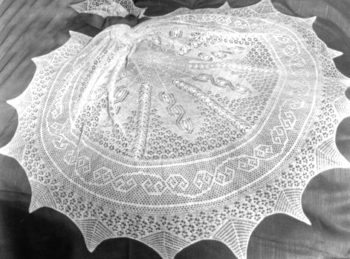
Margaret Stove of the Canterbury Guild was commissioned by the Merino Sheepbreeders’ Society to handspin and knit a shawl for the new royal baby, Prince William. The cobweb fine shawl was knitted to Margaret’s original design, depicting native flowers and Maori rafter-patterned inner border. The finished shawl weighed only 85 grams.
Yvonne Davison, Greymouth, became the editor of the web. An education fund was established by the Society in May. A capital sum from festival profits was invested and the interest provided the income to help groups finance workshops and individuals to attend schools and workshops. An executive subcommittee was set up to deal with financial matters consisting of President, Secretary, Treasurer and one other.
A trophy was donated by the three Wairoa clubs in memory of the founder, Eric Powdrell. The Powdrell Trophy to be awarded at each festival.
1983
New Plymouth hosted the festival and Jean Abbott became President.
Margaret Stove was elected to the New Zealand Crafts Council executive and Brigit Howitt was awarded a Fullbright Cultural Grant to study handweaving and design in the United States.
Handweaving Unlimited was held in Christchurch at the Canterbury Society of Arts Gallery and was opened by the Patron Lady Beattie.
1984
Festival held in Queenstown.
Coloured photos appeared in the web for the first time.
Assisted by the British Council, Peter Collingwood, one of the world’s best known weavers, attended the festival as guest artist. His exhibition of rugs and geometric macrogauze wall hangings was later hung at galleries in Nelson, Manawatu and Pakuranga. Whilst in the country he took two workshops and gave four lectures.
The project standing committee was renamed Exhibition Committee.
Extensions to Wool Board sponsorship were announced by the Chairman, Mr Douglas McIlraith, in opening the Hawkes Bay festival. Two design awards were to be offered for Art in Wool one year and Wool in Fashion the next. Other sponsorship money was to be used for such things as reprinting the Society guide, assisting with the costs of overseas tutors’ visits, design education material and holding judging schools.
Membership stood at 7,817, the highest in the Society’s history.
1985
Hawkes Bay hosted the festival which was held in Hastings.
Following festival Clotilde Barrett, founder of the Weaver’s Journal and author of several weaving publications, tutored thoughout the country.
Elizabeth Sim was appointed the first coordinator for trade displays at festival and the Worsted Threads film was completed during the year.
Life member cards and brooches were designed and sent to all life members.
Membership numbered 7,532.
1986
The festival was held in Tauranga where Nola Fournier became President.
The first Wool Board Design Award for excellence in fashion went to Lee Anderson as designer with Pam Elder and Beverley Eriksen as spinner and weaver.
Jean Abbott was appointed first fashion coordinator, responsible for administering Wool Board fashion design awards and to liaise with festival fashion convenors.
It was agreed festival profits be split on a 50/50 basis.
Kaffe Fassett, described as ‘a genius of the knitting needles’, toured with workshops and slide lectures, and in November, Navajo weaver Pearl Sunrise also visited New Zealand.
1987
Festival held at Lincoln College in Christchurch.
The Art in Wool Award was not made because the judges felt none of the works submitted came up to award standard. They were disappointed at the lack of basic design principles in the work submitted.
The New Zealand Wool Board announced that the unawarded prize money was to be used to raise the standard of design in woolcrafts. A correspondence course in design was developed which included the basic elements and fundamental importance of design as well as technique. Two modules, basic drawing and colour, were designed and tutored by Anna Day.
1988
Festival held in Epsom, Auckland. After the festival, tours were made by overseas tutors Catherine Mick (Canada), rag weaving; Bobbie Cox (England), tapestry weaving; and Sue Leighton-White (England), knitting.
A survey sent to 1000 randomly selected members asked whether their needs were being met and what changes to the Society they would like. The result was valuable in planning for the future.
Membership numbered 6,628.
1989
Festival hosted by Otago area in Dunedin.
A gradual decline in the interest of action competitions brought in proposals for a change in the format. The Action Standing Committee was disbanded and individual festival committees given the initiative.
To keep costs down, a management committee of President, Secretary, Treasurer, two Vice-Presidents and two co-opted members held teleconference meetings to deal with urgent business between the six-monthly full executive meetings.

At the festival a Society banner was presented by Otago Spinners and Weavers. Designed by Betty McCammon of evenweave fabric woven by Betty Booth from Perendale wool, it features the Society logo and carries the names of all the areas with space to add the years in which that area hosts a festival. At the conclusion of each festival it is handed onto the area which hosts the next one.
The touring tutor was La Vonne Schrieber, an American expert on Japanese controlled-dye techniques.
Margaret Stove became President. Margery Blackman was made a life member. A weaver since 1961, she founded the Dunedin Spinners and Weavers Guild in 1971. In 1976 tapestry weaving became her main creative interest and her tapestry workshops are known throughout the country. She is a dedicated and generous teacher. Margery was a foundation member of the NZSWWS Education Committee, served on the Web editorial for five years and organised the education programme for the 1981 Dunedin festival.
A grant of $7,000 was received from the Hillary Commissison for the production of a professionally designed Society brochure.
1990
Festival held in Palmerston North. The first felting workshop in the Southern hemisphere took place at Taupo during March. It was an untutored, hands-on sharing experience between felters who were mostly tutors themselves. It arose from Jeanette Green’s visit to Hungary and really set felting alight in New Zealand.
Tutors travelling after the festival were Canadian silk weaver Karen Selk and Shetlander Florence Shearer on Fair Isle knitting. Fleece selection classes were offered throughout the country by Nola Fournier, Lesley Wright, Lyn Finch, Noeline Falconer and Elaine Soanes. The second module of the correspondence design course was set up.
A seminar, Standards and Evaluation, was toured through both islands with Nola Fournier, Lesley Wright, Anne Gaston and Jay Venables.
1991
The International Weaving School of New Zealand set up specialised courses at Picton, opening on 3 February. A Liaison and Promotion standing committee was set up convened by Marie Harding.
Festival held in Hamilton. A new festival award was instituted by the Marlborough area, the award to honour a different Marlborough woolcraft worker each year. In 1991 it honoured Molly Duncan and was won by Pauline Pease. Following the festival, workshops were held with overseas tutors – Joanna Staniszkis, a tapestry weaver from Vancouver; Pauline Turner, a crochet tutor from England and Mary Rawcliffe Colton, a designer, weaver, dyer and photographer from New Mexico.
Jeune Duff was appointed as Convenor for the first Society diary which came about as a vehicle to showcase members’ work. It has proved a welcome fundraiser for clubs and the Society.
Membership stood at 5,245.
1992
On completion of the felting video ‘Felt-Noah to the 90s’, presentations of a felt jacket and felt boots were made to Edith Gates and her husband in appreciation of their work in producing the video.
In place of a full festival, Nelson hosted the woolcraft event ‘Textile Talents’ with no action competitions and no fashion parade, but a National exhibition hung in The Suter Art Gallery. There was a full education programme and a large trades hall as well as the annual general meeting.
Jay Venables became President.
1993
Festival held in Wellington.
An NZSWWS information booklet was being developed, partially as a resource when applying for sponsorship. Delegates’ and group leaders’ packs were comprehensive. The festival guidelines were being reviewed.
A presidential chain of office was designed and produced. It was woven by Mary Bartlett. Electric blue was adopted as the Society’s official colour.
A Wool Board scholarship in design, replacing the former awards, was won for the first time by Pat Old.
At the festival, Wairoa won both the Silver Spinning Wheel and Kiwicraft competitions and had the honour of cutting a cake made in celebration of the 25th anniversary of the first Silver Spinning Wheel contest in 1968.
1994
The mid 1990s were tumultuous times for the Society. In the Society news bulletin, The Woolcrafter, Vol. 1 No.I in March 1994, President Jay Venables stated ‘the period since July 1992 has probably been the most traumatic in the Society’s history – we have literally been within a hair’s breath of being bankrupted and forced into winding up’. The web magazine publication was autonomous and run as a separate entity within the Society. The then editor, Valerie Guilford, absconded with the large reserves the web had built up. Following much hard work by President Jay Venables and Secretary Heather Halcrow Nicholson she was found guilty in December 1993, sentenced to seven months periodic detention, 12 months supervision, but there was no order to pay reparation.
Further on in The Woolcrafter Jay went on ‘We are now in the year of our silver jubilee and will enjoy a variety of celebratory occasions. Whilst nostalgic reminiscences are inevitable and enjoyable, we must keep our sights firmly on the future. We must ensure our heritage crafts do not die. To do this we must be ‘inclusive’ and welcome those interested in ‘periphery’ crafts – our strength lies in numbers and within the organisation there is room to pursue their special interest.’
The secretary produced a bulletin reporting on Society business, which was distributed through groups and to individual members. Later this was expanded into The Woolcrafter but still distributed in the same fashion. It was hoped this would eventuate into a larger publication. Yvonne Davison was appointed Editor of The Woolcrafter, assisted by a team from Greymouth.
Spin a Yarn Weave a Dream, A History of the New Zealand Spinning, Weaving and Woolcrafts Society Inc. 1969–1994, editors Jean Abbott and Shirley Bourke, was launched. This book required a huge amount of research and was very well received.
Fibre Fiesta event was held in March 1994 in Timaru.
The national exhibition was held at the Aigantighe Gallery, Timaru, from 25 March to 10 April 1994, in conjunction with Fibre Fiesta. At the AGM life membership conferred on Nola Fournier of Nelson. She was Delegate 1978–82, President 1986–89, is a talented craftswoman, patient teacher and greatly respected by all.
1995
Southland hosted festival in Invercargill 17–19 May. The national exhibition was mounted at the Southland Museum & Art Gallery, 17 May–5 June. Leni Neilsen Danish felter attended and also made a comprehensive tour of New Zealand tutoring. 1995 Wools of New Zealand Scholarship in Design was awarded to Beryl Denton. Alison Hurley took office as Society President.
Society membership had fallen from its peak of 7,817 in 1984 to 4,365. Financial reserves were very low and it became evident the Society was ‘living beyond it’s means’. The managerial structure that was appropriate earlier was not appropriate for the much lower number of members. Restructuring had been considered for some time and Alison Hurley took on the unenviable task of putting this into practice. The Society had been run through a series of committees (standing) and as stated previously, the magazine a separate entity. The first thing Alison Hurley did was to have The Woolcrafter distributed to every member’s mailbox. In this way all members were kept fully aware and informed.
Another blow was the fact that in spite of all their hard work the festival in Invercargill had made a substantial financial loss. This put further strain on financial resources. The whole Society was looked at as one entity with every facet scrutinised for its cultural as well as financial effectiveness. There were hard decisions to be made and it was decided to try and work within the working budget rather than take the easy option of raising subscriptions.
The entire council consisting of President, Secretary, Treasurer, Education Convener, Exhibition Convener, Quality Mark Convenor and delegates attended meetings twice a year. Incoming delegates attended the festival meeting as observers. From 1996 only one delegate (the delegate to be responsible for the coming year) from each area attended the festival meeting with costs shared between the national Society and area.
National exhibitions were another costly part of the Society. There was a large exhibitions committee who often had two visits, one for selection and one when the exhibition was being hung, to the venue. The Fashion Parade worked with a much smaller number of people and as there were many people around the country experienced in mounting exhibitions it was resolved a smaller number of the committee would travel in the future.
To raise the standing of the exhibition both among exhibitors and the wider public the prize money for the main Creative Fibre award was raised to $1000, an outside selector being asked to select it. It was hoped the Fashion Parade main award could be increased to the same value as funds allowed.
It was resolved that Quality Mark was really education and in future it would come under the Education Committee umbrella.
1996
Monica Vance tutored a Correspondence Course in Design. Taranaki hosted festival in New Plymouth 17–19 May. Liz Williamson, renowned weaver from Australia was guest tutor there and also selected the main exhibition award. She conducted a workshop tour of New Zealand.
Jean Abbott, Taranaki, was presented with Life Membership for her outstanding service to the Society. Jean was Delegate 1971–74, President 1983–86 and the editor of the Society’s history, 1969–1994, Spin A Yarn Weave a Dream.
Subscriptions were raised by $3 to cover the cost of The Woolcrafter being sent direct to all members.
The Spinning Weaving and Woolcrafts Society Inc. is a very cumbersome name. In 1996 it was decided to adopt a common name. Members were asked to suggest names and there were two front runners. Creative Fibre was chosen over Woolcrafts to reflect the increased diversity of fibres other than wool used, to include other crafts than spinning and weaving, and to acknowledge that crafts were becoming more often combined. It was still the same organisation but with a much wider base.
After much thought and consultation, with members and the Society solicitor, it was resolved to place the day to day running of the Society in the hands of a differently constructed executive of eight members, seven of these elected through the members and one appointed member. The structure: president, secretary, treasurer (nominations called for from general membership), and four delegates (one of whom becomes vice-president) who had been elected through their Area members and the Education Convenor (appointed by the executive). The executive delegates had specific responsibilities such as exhibitions, festival, communications, promotions. As a result of this change only this Executive met for the first time in later 1996 in a motel in Nelson. To save costs Nelson members provided the main meals and the president slept on the floor!
Sponsorship had been obtained from the NZ Romney Sheepbreeders’ Ass. and Romney wool they donated was distributed to members. A Society promotion week was held throughout New Zealand in June.
1997
Museum of New Zealand Te Papa Tongarewa commissioned a tea cosie from each of the Society’s areas. They wanted amazing, exciting and innovative articles to rotate as part of ‘On the Sheep’s Back’ exhibition planned for the new museum. They were thrilled with the results for this light-hearted, humorous display.
West Coast hosted ‘Wool Fever’ festival in Greymouth 17–20 April. The Creative Fibre Box Challenge took place and all panels were displayed.
Wrapt in Romney; all articles (over 300) made from the donated Romney fleece were shown in Area displays.
British crochet experts James Walters and Sylvia Cosh were guests there, also selecting the Creative Fibre Award in the National Exhibition and the Supreme Award in the National Fashion Parade, which had been raised to $1,000.
Walters and Cosh also carried out an extensive New Zealand teaching tour.
At the AGM the matter of selection for the national exhibition was raised after it had been discussed fully at the council meeting. It was resolved that in 1998 a single selector, with technical assistance as requested, be trialled. This was by no means a unanimous decision but the rationale was that we were judging ourselves by ourselves and to grow and become recognised by a wider audience our work must be viewed and selected by our peers.
1997 Wools of New Zealand Scholarship in Design won by Sandra Heffernan.
A closeup of felt by Kate Mahoney (formerly Buckthought) became the official Society graphic. A grant was obtained from Creative New Zealand for a new brochure. The graphic was used on the cover designed by Nola Fournier and Francie Dulieu.
1998
The draft revised constitution prepared under the guidance of Mr Nick Miles of Rainey, Collins, Wright & Co, Wellington, the Society’s Honorary Solicitor, was published in the March Woolcrafter. This was one of the requirements of the tax law changes regarding incorporated Societies and tax exemptions. It reflected the changes in the Society’s structure and included the provision for every member to have a vote if the situation required it. The draft also had the inclusion of Creative Fibre as the Society’s common name.
Creative Fibre festival Kaitaia 16–19 April (the first time Creative Fibre festival was used). Flax was a festival focus, with flax weavers Florrie Berghan and Lydia Smith of Ahipara, being guest exhibitors in the exhibition.
A grant was received from Creative NZ. Tom Moore, creative knitter, designer, and tapestry weaver of repute from Australia was guest tutor and conducted a New Zealand teaching tour. Tom also became the first solo selector of the National Exhibition. Technical Advisers available were Jenny Poore, Lynn Carrad, and Lydia Smith. Tom also selected the major award in the National Fashion Parade.
The revised constitution was adopted at the AGM.
Joan McLauchlan, became President.
The Society’s publication shifted its base to Takaka with Jan Morgan as editor. Its name became Creative Fibre reflecting the Society’s common name.
Creative Fibre’s web site is launched late in the year. Lorraine Major, who with Jean McIver, did a vast amount of work to get this up and running, became the first Webmaster.
1999
Pauline Pease was appointed as the first National Exhibition Liaison. Festival Palmerston North 14–17 April. Pat Johns, tapestry weaver from England was guest tutor and National Exhibition sole selector. She taught colour and design, and tapestry weaving master classes while she was in New Zealand. Her travel costs were paid by the Society from the Manawatu festival distribution. The national exhibition was hung at the Manawatu Art Gallery 16–23 May. The national fashion parade garments were shown after the parades in an ‘exhibition’ setting rather than on racks so they could be seen to their best advantage. The traders held regular working demonstrations to encourage visitors to try all techniques with many day visitors resulting. Areas had been asked to create ‘scarecrows’ and a large colourful display was mounted. The Vest/waistcoat Challenge provided a large display. Generous sponsorship from Merino New Zealand resulted in many articles from merino wool being made. All of these were shown in area displays at festival.
A book collated by Marjorie Gillespie and the Pahiatua Spinning and Weaving Club, Patterns from The Web, was launched at festival. Profits from this popular publication (many thousands of dollars) have all been donated to the Society in the years that followed.
Colour was introduced into the Creative Fibre magazine in June.
Quality Mark had served the Society well for many years but in spite of much extra publicity and encouragement for many years the number of members applying was very small and the cost, in its present form, could not be justified. The Committee was disbanded after the October assessment.
In a promotion effort to attract more members study collection emphasis was shifted from perfection to a specific topic or inspiration. A Flax Study and a Colour Inspiration Collection being the first two.
Jean McIver became Society Promotions Officer, a newly created position.
2000
Creative Fibre festival Christchurch 8–11 April. Jeanette Appleton, British Textile Artist, feltmaker and embroiderer was guest tutor with festival underwriting her travel costs. Jeanette undertook an extensive New Zealand teaching tour before festival. Myrna Starman, lace knitter tutored at festival. Her trip was her own arrangement but Creative Fibre organised three North Island workshops post festival.
The Creative Fibre Award in the national exhibition was raised to $2000.
A new correspondence course ‘Understanding Colour’, tutor Philippa Vine, was offered.
The Wool Board stated they had enough money for one last Scholarship in Design. A new format with new aims, responsibilities and commitments by the winner, and new methods of choosing the recipient was adopted. Caroline Moreton received the Scholarship.
A Self-Directed Learning Programme was introduced. Costs were subsidised by a bequest to the Society.
2001
Australian weaver Kay Faulkner, in New Zealand for a private visit, gave workshops and lectures.
Each Area was provided with a Fleece Focus File to assist new spinners learn about wool and its properties.
Poverty Bay area hosted a smaller festival, East Coast Experience, 4–6 May, in Gisborne. In a huge departure from normal gallery protocol five separate small exhibitions, Sun Fun challenge box, Sun Fun Hats, a Mohair display, Ode to a Challenge, and Scrumbles, were sited throughout the Tairawhiti Museum, Gisborne.
Anthea Davidson became President.
A set of eight greeting cards was produced.
A stand alone national Creative Fibre exhibition was mounted at the Academy Galleries, New Zealand Academy of Fine Arts, Wellington, 7–29 September. This was the first national exhibition to be held separately from a festival. It achieved record number of entries, attendance figures, and sales.
2002
Creative Fibre festival, Taupo, 16–19 May. American weaver Bonnie Inouye was guest tutor. Ank Hazelhof and Maya Siepel, two of the five innovative weavers from the Dutch group Cocon, mounted an exhibition of work and lectured there. Following festival their exhibition travelled to galleries in Blenheim, Dundein and Auckland. This was an exciting venture for the Society with cost being shared between the Dutch Embassy, Waikato festival and the Society. For the first time, in line with the national exhibition, a single selector, Vicki Catlow, selected the national fashion parade.
Laurel Wheeler (teacher Cliff Cavill) and Kyoko Ichikawa (teacher Lesley Nicholls) shared the first New Weaver Award.
Following the demise of the Wool Board another sponsor had to be found for the Scholarship in Design. Anthea Davidson was successful in obtaining the Mason Trust of New Plymouth as sponsor helped by an excellent proposal by Jean McIver. A new correspondence Design Course, tutor Alison Francis, was offered. The Mason Charitable Trust Scholarship in Design was won by Shona Schofield.
For the first time since the mid-eighties Society membership increased, being 3,514.
2003
Creative Fibre festival, Cromwell, 13–16 April. Anne Shuttleworth, felter and tapestry weaver from Australia, undertook an extensive teaching tour before festival with sponsorship from the Mason Charitable Trust. She also tutored at festival. Creative Fibre fashion award raised to $2,000.
The Council reaffirmed that Creative Fibre, NZSWWS, is open to all who work with fibre, embraces all fibre art and craft and that ‘all facets of fibre creations are welcomed’.
2004
Creative Fibre festival ‘Shear Fibre’ held by Wellington in Masterton, 15–18 April. Prior to festival the Creative Fibre national exhibition was mounted for six weeks at Aratoi Masterton’s Museum of Art and History. Its opening coincided with the Golden Shears event. Black and Coloured Sheep Breeders’ Association of New Zealand donated fleece with articles made being shown at festival in area displays.
Robyn Hogg became President. A new Society position is created and Anthea Davidson became Archives and Collections Officer.
‘Travel a Tutor’ programme took place with two New Zealand tutors exchanging Islands and making extensive tours – felter Raewyn Penrose went to the South Island and weaver Lesley Nicholls to the North.
Monica McConnell was awarded the Mason Trust Scholarship in Design.
Spinning Merino a new correspondence course tutored by Margaret Stove was offered. It would take place in 2005.
2005
Advanced Design Course tutored by Alison Francis was offered. Creative Fibre was registered as a trademark.
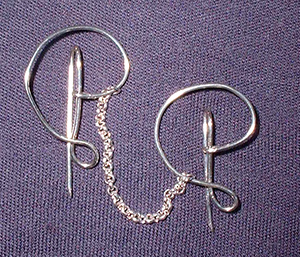
Creative Fibre festival ‘Fibretime’, Ashburton, 19–22 April. Erica de Ruiter, weaver from the Netherlands, was guest tutor. She also had a New Zealand tour pre and post festival.
Past Presidents brooches designed and made by Lesley Nicholls were presented to Margaret Stove, Alison Hurley, Joan McLauchlan and Anthea Davidson who were present at the AGM. Other past Presidents were to be presented with their badges as soon as practicable.
The keeping of the NZSWWS membership database was split from the Treasurer’s role. Judith Hebberd, who was also on the Creative Fibre magazine team, took up the new position.
National Creative Fibre exhibition was mounted, 8 September–1 October at the Academy Galleries, New Zealand Academy of Fine Arts, Wellington as a stand-alone exhibition.
Unfortunately due to ill health and work commitments Robyn Hogg resigned from the presidency at the September Executive meeting.
Vice-president Essie Colville became President.
2006
Creative Fibre festival ‘Art Deco’, 20–23 April, Taradale, Hawkes Bay. Lynne Johnson, creative knitter from Australia, was guest tutor at festival. Focus on Fleece – strong wool educational challenge was mounted.
Affiliation fee increased by $3.00 to $18. Nynke Piebenga became President.
Travel a Tutor took place again with Jenny Hart and Pat Old tutoring spinning around New Zealand. A promotional Creative Fibre week was held 3–9 July. The request from Medicine Mondiale to knit baby hats to be sent to Nepal received a huge response. Local charities in New Zealand were given the excess hats that were not suitable for the overseas project.
The Mason Trust Scholarship in Design was awarded to Leigh Morris.
2007
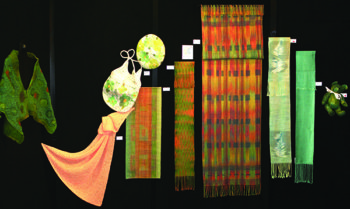
Creative Fibre festival ‘Celebrating Diversity, Mountain to Sea’, New Plymouth, 12–15 April.
Helen Beale Stedman, basket maker, and Helen Stumkat, felt maker, Australia were guest tutors for festival. Travel assistance was provided by the Mason Trust.
Following festival the national exhibition was then mounted in the Percy Thomson Gallery, Stratford 18 April–2 May.
2008
A survey was sent to all members via Creative Fibre magazine requesting their input and feedback. Approximately 15% of members responded.
Winter Woollies Weekend Gisborne 10–13 July. This event was timed to coincide with Fibre and Fleece in Opotiki. Articles from the Corriedale Fleece Educational Challenge were shown.
Inaugural Linen Trust Scholarship of $2,000, for linen weaving, was presented to Theresa Wyatt. Her tutor will be Betty Booth.
A post card featuring flax weaving by Tangi Robinson, a membership card lanyard, and laminated Creative Fibre charts were offered for sale.
The affiliation fees for 2009 were raised to $25 for group members, $35 for individual members and $40 for overseas members.
Weavers Nynke Piebenga, central area, Anne Field, north, and Margaret Mecchia, south, were the travelling tutors for 2008.
A pilot group trialed a Modular Spinning Correspondence Course.
National Creative Fibre exhibition was mounted in Claudelands Events Centre in Hamilton 18–23 September. This was at the same time and in the same venue as the Australian Craft and Quilt Fair. A selection of the exhibition was then hung at the Canterbury Museum 3–12 October, before travelling to the Southland Museum and Art Gallery and mounted there from 1–30 November. A special colour catalogue was produced.
Membership numbered 3,180.
